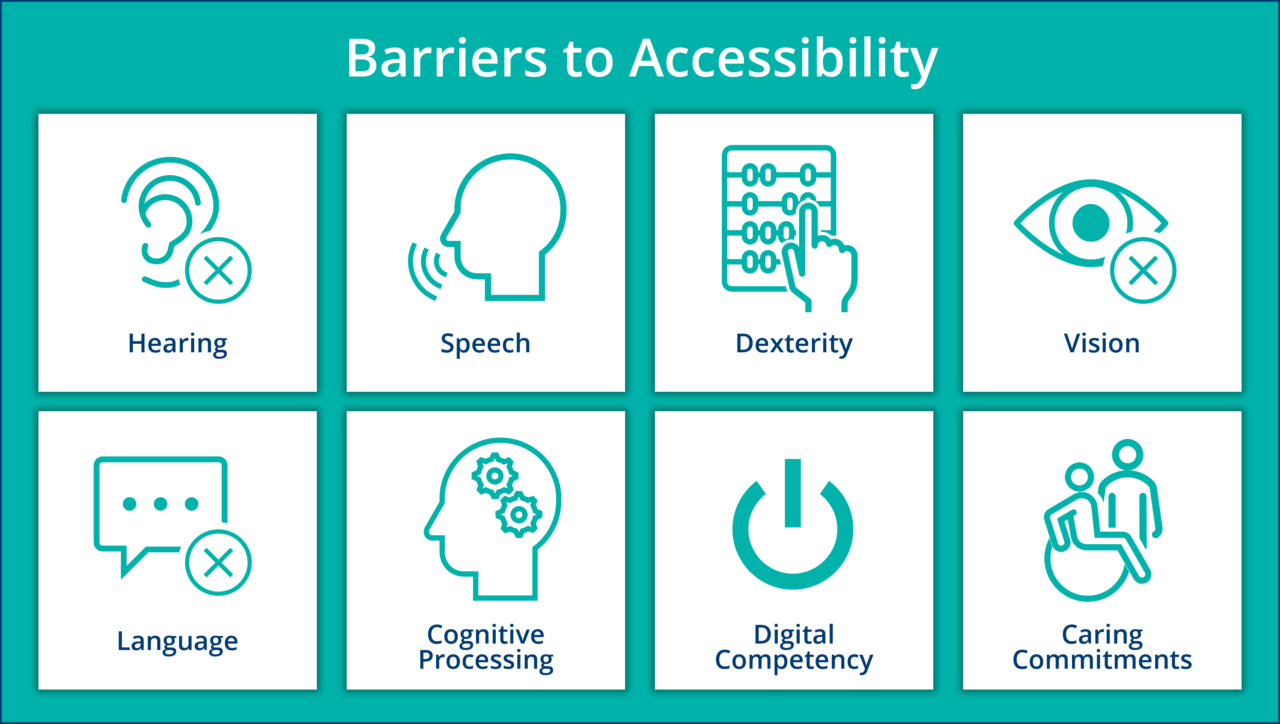Menu

Here’s Why Employers Need to Start Addressing the Ambiguity of Accessibility
Over 1 in 4 of the population are struggling to access the services and products they need … that’s around 18 million people in the UK!
And although the term ‘accessibility’ is nothing new, it can be hard to pin down exactly what it means to your organisation or business.
This is because when people hear ‘accessibility’ they tend to think ‘disability’.
It is, however, important for employers to get beyond this ambiguity and focus on creating inclusive experiences that can be accessed by everybody.
So, the first step is to understand what accessibility really means: ‘Ensuring people can do what they need to do in (approximately) the same time as someone who does not have an accessibility need’.
Secondly, leaders need to understand what their consumers and employee’s accessibility needs are so they can work out how best to accommodate for them. To do this we have identified 8 potential barriers to accessibility that need to be considered:

- Hearing – 12 million adults are deaf, have hearing loss or tinnitus, which is estimated to increase to 14.2 million by 2035.
- Speech – This includes those with speech impediments, those who are physically unable to speak and those who are non-verbal.
- Dexterity – 22% of working age adults in the UK have issues with dexterity.
- Vision – Over 2 million people in the UK have sight loss, and 1 in 5 will live with sight loss in their lifetime.
- Language – There are over 300 different languages spoken in schools across the UK, with many people not speaking English as their first language. Therefore, it is likely that for many people applying for jobs and using services, there may be a potential language barrier that is making these things inaccessible.
- Cognitive Processing – This includes those that suffer from memory disorders, or those who process information at different speeds due to many factors (such as proficiency or neurodivergence).
- Digital Competency – Technology designers work hard to ensure that the user experience is easy to grasp as possible – for example many of the icons we use every day have been inspired by their traditional ‘physical’ counterparts; folder, camera, mail, etc. However, some of the most basic elements of tech may not be as intuitive – for example, if you didn’t know the symbol for the On/Off button would you be able to guess?!
As a result, more than 1 in 5 in the UK still lack the means or skills they need to effectively operate in today’s digital world. - Care and Commitments – There are as many as 10.6 million unpaid carers in the UK, and these people find themselves dealing with an array of accessibility barriers, especially from a cyber security perspective. For example, they are an acting representative for someone where often data security makes it hard to complete tasks.
Without doubt, accessible services are widely underdeveloped from a business perspective. But there is a huge opportunity to both impact the bottom line and positively impact brand image and consumer loyalty.
Marketing experts will tell you that 95% of consumers say that customer service has an impact on brand loyalty and that 41% of consumers will abandon a brand after two bad digital interactions. To put a figure on this, it’s estimated that £17.1 billion a year is lost due to people abandoning online shopping because of accessibility barriers.
Now apply this mindset to accessible consumers who will, more often than not, struggle on a day-to-day basis with life’s basics. When they are treated with care and consideration and are able to achieve what they set out to do with relative ease, they naturally form strong emotional bonds that go beyond logic and rationality. This phenomenon has been dubbed ‘loyalty beyond reason’.
The truth is accessibility is a broad term that encompasses many more factors than many employers realise, and of course no one-size turnkey solution exists. But if you take time to look, you will see that all big software providers are now providing accessibility features on their platforms. Not only is this a sign that they have recognised both the issues (and the potential) surrounding accessibility, these changes also provide the rest of the business world an opportunity to utilise these tools to their advantage.
The key is stepping back and taking time to understanding the context in which a consumer or employee with accessibility needs is operating. Once you have this and begin to apply it to your business context, then you can begin the journey of incremental steps steadily adapting your ways of working and service provision.
If you would like to discuss the topic of accessibility in more detail and how it can make your business brand stronger, more profitable and sustainable, please get in touch with me at gavin.jones@orgshakers.com



